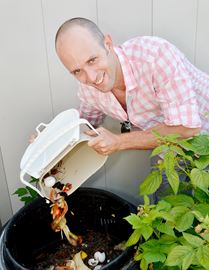More to the point, what is the mixture of variables used and how much of each does it take to screw in a light bulb?
 |
| Answer: 42 |
I recently watched a Netflix documentary on algorithms, and I must say, I got it, I get it, yeah, thanks for the cheese. Let me explain potatoes before I handle correlating quantum physics and particle theory.
In a nutshell, identify all aspects of what constitutes a recipe (ingredients and methods). Add a value to each variable within each aspect, then conclude with a correlated ratio to determine the balance of each in order to replicate its properties within other recipes.
Or, I dunno... I guess.
You need to know my potato pave recipe is excellent.
Lets say, if we were to muse a breakdown of the essential components of what constitutes a good pave, then extrapolate the core 'good' essence of their fundamentals, we could then be able to build a theoretical formula to mathematically tells us why my potato pave recipe is just so damn nummy.
 |
| Lets tinker |
Ingredients
Yukon Gold Potato (3)
Heavy Cream (3)
White Mirepoix (2)
Garlic (2)
Aromatics (bay leaf, thyme, white peppercorn) (2)
Parmesan (3) fuuuuuuccckkk yeah, ITS THE KING OF CHEESES!
Kosher Salt (3)
Next, a breakdown of steps used to produce the recipe, with again, a rating system from 0 to 3 to hone in on the significance and degree of attribution each step contributes towards excellence.
Method
-In a thick bottom sauce pot, add the cream with mirepoix, garlic, and aromatics. Bring to a boil, reduce heat, let steep for 20 minutes. (3)
-Concurrently, peel the potatoes, and using a mandolin, slice to a thickness of 2mm. (3)
-Using a fine mesh chinois, strain the warm cream into a stainless steel bowl with the peeled potatoes. (2)
-Add parmesan. (3)
-Thoroughly mix the peeled potatoes and cream mixture together. Take your time and peel apart the layers of potatoes to coat as many individual slices as possible. (2)
-Add salt to taste (3)
-Layer the slices of coated potatoes into a parchment covered hotel pan. Go layer by layer, ensuring the levels are leveled. Layer until finished - or until you reach a depth of 1 inch. (3)
-With your hand, press the top layer down gently. There is enough cream in the mixture if you see cream rise to the service when you gently press down. If no cream rises, add cream. Strain if the potato is drowning in cream. (2)
-Cover the top with parchment paper, then cover with another hotel pan. Blind bake at 375F for 55 minutes. (3)
-Once cooked, remove the pans from the oven and place about 10lbs. of weights on the top hotel pan and allow the pave to cool for 24 hours in the fridge. (2)
-Portion as needed, reheat as individual portions. (1)
 |
| "Everything ends up better when they endure a little pressure" -me, just now |
Next, we tally the variable numbers for both ingredients and methods and add up their relevancy scores within their own category;
Ingredients
7 key ingredients with a total relevant score of 18
Method
11 key steps for a total relevant score of 27
We may then deduce that, giving the ingredients score of 18 and methods of 27, the most common denominator for both would translate to a 2:3 ratio.
Therefore, based on my potato pave recipe, which really is fantastic, the key to a good recipe is to follow 2 parts good ingredients to 3 parts good techniques in execution.
Neato Right?
The actual recipe is below - enjoy!
Jerek
Potato Pave
Yield: 1 Hotel Pan (25 Portions)
Ingredients:
25lb. Peeled Yukon Gold Potatoes
1lt. Heavy Cream
2 Shallots (Peeled and Rough Chopped)
2 Stalks of Celery (Rough Chopped)
5 Gloves of Garlic
15 Whole White Peppercorns
2 Bay Leaf
10 Sprigs of Thyme
1.5 Cups Parmesan Reggianno (Finely Grated)
Kosher Salt (To Taste)
Method:
1) In a thick bottom sauce pot, add the cream, shallots, celery, garlic, peppercorns, bay leaf, and thyme. Bring to a boil, reduce heat and allow to steep for 20 minutes.
2) While the cream is infusing, use a mandolin to slice the potatoes about 2mm thick. Place into large stainless steel bowl.
3) Use a non-stick spray to cover a hotel pan. Then place a sheet of parchment paper inside the pan to fully hold the potato mix.
4) Using a fine-mesh strainer, strain out the cream and pour directly onto the sliced potatoes. Discard the remaining ingredients from the strainer.
5) Add all of the parmesan and salt to the sliced potatoes. Very thoroughly mix together – taking the time to separate the individual slices of potatoes, so as to ensure best distribution of seasoning and cream. Taste a potato. It should be slightly on the salty side, as the potato has yet to absorb any seasoning.
6) Using your hands, pick up and evenly place the slices of potato onto the hotel pan. Go layer by layer until all potato is used. Ensure the placement of potato is equally layered and even.
7) Ensure there is enough cream in the potato mix by pressing the palm of your pan down on the layered potato – if you see cream just rising to the service, it is perfect. If no cream appears, add enough to facilitate. If too much cream is present, you must strain out the cream until it is perfect.
8) Cover the service of the pave with another sheet of parchment. Then, place another hotel pan on top of that.
9) Blind bake the potato pave at 375F for 55 minutes.
10) Remove from the oven and place weights on top of the top hotel pan (About 10lbs is fine) and refrigerate for 24 hours, until completely chilled and pressed.
11) Cut as needed and reheat in an over until warmed through.












